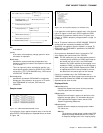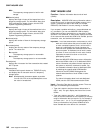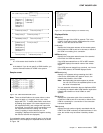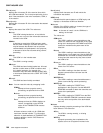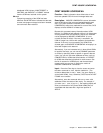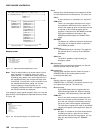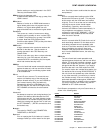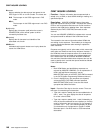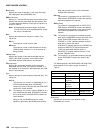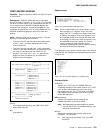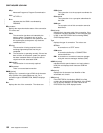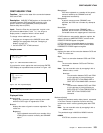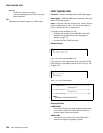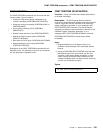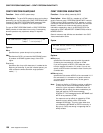
CEMT INQUIRE UOWENQ
─ ──CEMT Inquire UOWEnq ──┬ ┬──────────── ───────
└┘──Uow(value)
─ ──┬ ┬──────────────── ──┬ ┬─────────────── ──────
└┘──TRansid(value)└ ┘──TAskid(value)
─ ──┬ ┬────────── ──┬ ┬───────────── ──────────────
├ ┤─ACtive─── ├ ┤─Dataset─────
└ ┘─RETained─ ├ ┤─File────────
├┤─EXecenq─────
├┤─ADdrexecenq─
├┤─TDq─────────
└┘─TSq─────────
─ ──┬ ┬──────── ──┬ ┬───────────────── ────────────
├┤─Owner── └ ┘──Netuowid(value)
└ ┘─Waiter─
─ ──┬ ┬───────────────── ──┬ ┬───────────────── ───
└┘──ENqfails(value)└ ┘──RESource(value)
─ ──┬ ┬───────────── ──┬ ┬────────────────── ──────
└┘──RLen(value)└ ┘──QUalifier(value)
─ ──┬ ┬───────────── ─
└┘──QLen(value)
Sample screen
INQ UOWE
STATUS: RESULTS
Uow(AC1431D4A7261) Tra(CECI) Tas(38) Act Exe Own
Res(ACCOUNTS.DBASE1 ) Rle(15) Enq()
Uow(AC1431D4A7261) Tra(CECI) Tas(38) Act Add Own
Res(g... ) Rle(4) Enq()
Figure 133. CEMT INQUIRE UOWENQ screen
Note: There are blank fields on the screen where a value
does not apply or is ‘negative’; that is, the value
begins with ‘No’. To modify these fields, locate them
by tabbing (they appear in the same sequence as in
the expanded format), and overtype with input valid
for that field. You may find it more convenient to use
the expanded format when setting one of these
values, (negating is easier because you are
overtyping a displayed field with its negative causing
the result to become non-displayed).
If you place the cursor against a specific entry in the list and
press ENTER, CICS displays an expanded format as shown
in Figure 134.
INQ UOWE
RESULT
Uowenq
Uow(AC1431D4A7261)
Transid(CECI)
Taskid(38)
State(Active)
Type(Execenq)
Relation(Owner)
Resource(ACCOUNTS.DBASE1)
Rlen(15)
Enqfails()
Netuowid(..GBIBMIYA.IYA2T5C2...Mx...)
Qualifier()
Qlen()
Figure 134. The expanded display of an individual entry
Displayed fields
| Duration(
value
)
| displays the elapsed time (in seconds) since the
| enqueue f entered its current state of OWNER, WAITER
| or RETAINED.
| ENQFails(
value
)
| displays, for enqueues held in retained state, the number
| of failed enqueue attempts for this resource since the
| enqueue was last acquired. This indicates how many
| UOWs have received LOCKED responses due to this
| enqueue. The ENQFAILS option helps you identify
| which UOWs are causing “bottlenecks.”
| For enqueues held in action state, ENQFAILS displays
| zero.
| ENQScope(
value
)
| If the enqueue has sysplex scope, ENQSCOPE displays
| the 4-character name which was used to qualify the
| sysplex-wide ENQUEUE request issued by this CICS
| region. If it has region scope, ENQSCOPE displays
| blanks.
| All CICS systems with the same ENQSCOPE value
| share the same sysplex Enqueue name space.
Netuowid(
value
)
displays a 27-character string containing the
network-wide LU6.2 name of the UOW that owns or is
waiting for the enqueue.
Note: Nondisplayable characters appear as periods.
You can use PF2 on the expanded panel: to see
the value in hexadecimal.
QUalifier(
value
)
displays a 1- through 255-character qualifier (for
example, record id) that further identifies the resource
associated with the enqueue lock. The data displayed
depends on the type of enqueue, as shown in Table 3
on page 150. If no QUALIFIER data applies (that is for
EXECENQ, ADDREXECENQ, or TSQ), a value of zero
is displayed.
QLen(
value
)
displays the length of the data, in the range 0 through
255, displayed in the QUALIFIER field.
RELation
displays whether the data is associated with the owner
of the enqueue or with a task waiting for the enqueue.
The values are:
Owner
The (
value
), NETUOWID, TASKID, and TRANSID
are those of the owner of the enqueue.
Waiter
The (
value
), NETUOWID, TASKID, and TRANSID
are those of a waiter for the enqueue.
Chapter 11. Master terminal CEMT 149



